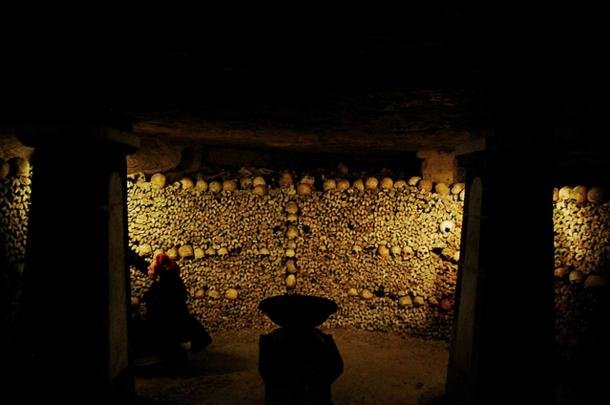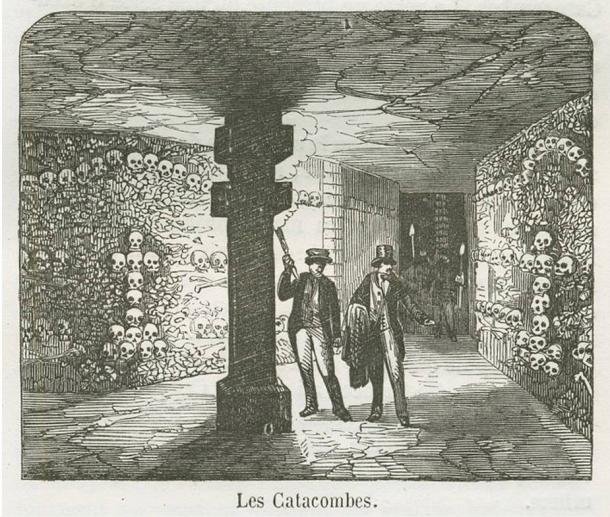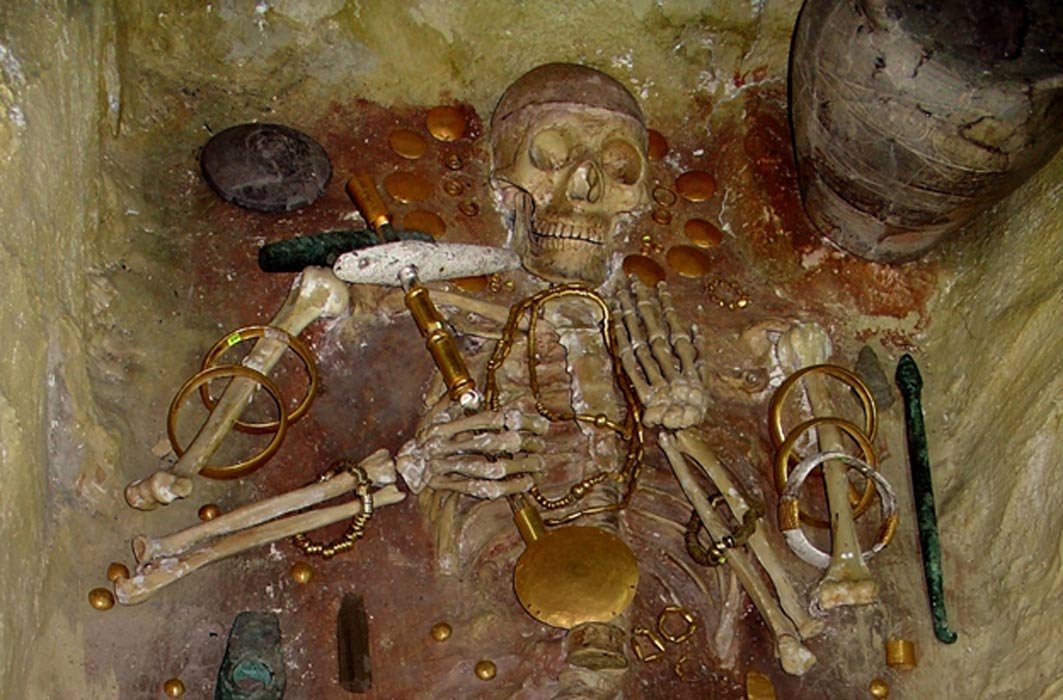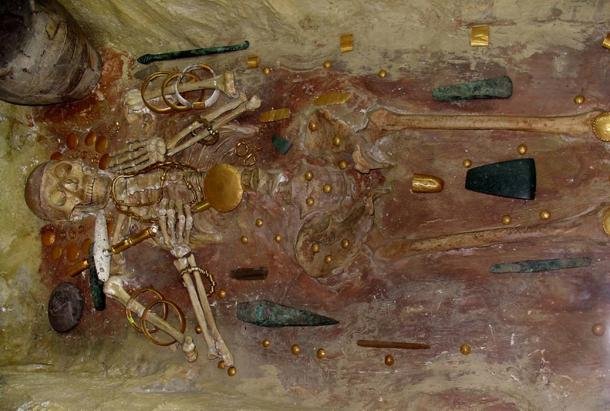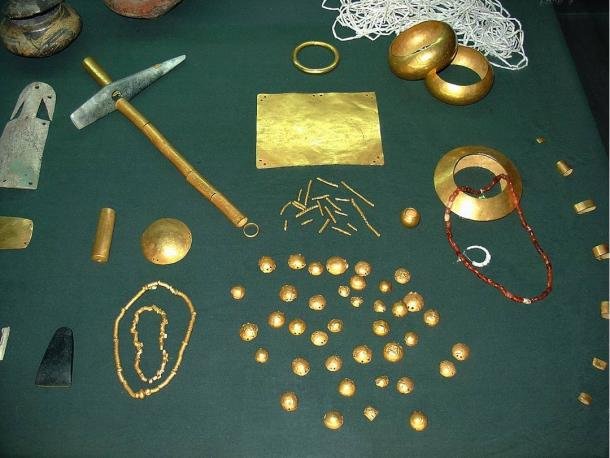In this video we will be exploring enormous ancient structures that time almost forgot, but we surely didn’t. Enjoy!
Scariest Recent Discoveries About Mankind
In the following video we will be exploring the scariest most recent discoveries about mankind. Enjoy!
Mysterious & Bizarre Discoveries
In the video below we will be talking about mysterious and bizarre discoveries. Enjoy!
The Dark Underworld of the Paris Catacombs
Paris, the capital of France, is often called La Ville Lumière (meaning ‘The City of Light’), however, beneath this bustling European city of 12 million people, lies a dark subterranean world holding the remains of 6 million of its former inhabitants. These are the Paris Catacombs: a network of old caves, quarries and tunnels stretching hundreds of miles, and seemingly lined with the bones of the dead.
Some areas are open to the public as museums, but since 1955 entrance to the majority of the underground space is prohibited. However this hasn’t stopped some thrill-seekers venturing into the cavernous passages that have been home to thousands of upon thousands of bones of the dead. As the water table has risen under the city, many of these spaces are now filled with cool and clean water. Locals are well aware of this, and, according to Bobrtimes , this year’s long, sweltering summer has seen an increase in illegal entrance to the catacombs as people seek a respite from the heat by using the subterranean pools as cooling zones.
But these desperate measures could have dire consequences. Just last month, two teenagers were rescued from the catacombs after being lost in the vast network for 3 days. They were found by rescue dogs and were taken to hospital to be treated for hypothermia, reported The Guardian . It was not known exactly how the boys got lost, but this occurence, along with the recent Thai cave emergency rescue, highlights just how easy it can be to get lost or cut off in such environments.
Origins of the Paris Catacombs
The Paris Catacombs have their origins in the limestone quarries situated on the outskirts of the city. This natural resource has been in use since the time of the Romans, and provided construction material for the city’s buildings, as well as contributed to the city’s growth and expansion. It was only after during the second half of the 18 th century, however, that the former limestone mines (now under the city as it expanded over the centuries) were transformed into burial places.
By the 18 th century, Parisian cemeteries such as Les Innocents (the largest cemetery in Paris) were becoming overpopulated, giving rise to improper burials, open graves, and unearthed corpses. Quite naturally, people living close to such places began complaining about the strong stench of decomposing flesh and the spread of diseases from the cemeteries.
In 1763, an edict was issued by Louis XV banning all burials from the capital. The Church, however, did not wish to disturb or move the cemeteries, and opposed the edict. As a result, nothing was done. The situation persisted until 1780, when an unusually long period of spring rain caused a wall around the Les Innocents to collapse, resulting in the spilling of rotting corpses into a neighboring property. By this time, the French authorities were forced to take action.
It was only in 1859 that the final transfer of bones was undertaken during the renovation of Paris by Georges-Eugène Haussmann, and the work was finally completed in 1860. Seven years later, the catacombs were open to the public. In total the winding catacombs stretch over 300 kilometers (186 miles).
The Weird Underworld of the Catacombs
Although the Paris Catacombs are still open to the general public today, access is limited to only a small fraction of the network. It has been illegal since 1955 to enter the other parts of the catacombs.
Nevertheless, during the 1970s and 80s, the catacombs have been explored illegally by Parisian urban explorers known as Cataphiles. Some of the spaces have even been restored and turned into creative spaces. One of these underground caverns, for instance, was transformed into a secret amphitheater, complete with a giant cinema screen, projection equipment, a couple of films and seats. The neighboring area was revamped into a fully-stocked bar and a restaurant, perhaps where the patrons of the amphitheater could get a snack or a meal.
It has been estimated that as many as 300 Cataphiles enter the catacombs each week via secret entrances. Non-Cataphiles and tourists, however, are not often welcome.
From its beginnings as a limestone quarry to its use for the burial of the dead in the 18 th century, and the part it plays today in the lives of the Cataphiles, the Paris Catacombs have been an important feature of the city.
Although systematic exploration of the underground tunnels may bring to light the extent of the catacombs, it would probably not meet with approval from all quarters. After all, the secrecy of the catacomb networks, and the opportunity to escape from the hustle and bustle of the city above, are attractive concepts to the Cataphiles, and they would probably not let go of their haunts so easily.
Britannic, sister ship to the Titanic, sinks in Aegean Sea
The Britannic, sister ship to the Titanic, sinks in the Aegean Sea on November 21, 1916, killing 30 people. More than 1,000 others were rescued.
In the wake of the Titanic disaster on April 14, 1912, the White Star Line made several modifications in the construction of its already-planned sister ship. First, the name was changed from Gigantic to Britannic (probably because it seemed more humble) and the design of the hull was altered to make it less vulnerable to icebergs. In addition, it was mandated that there be enough lifeboats on board to accommodate all passengers, which had not been the case with the Titanic.
The nearly 50,000-ton luxury vessel, the largest in the world, was launched in 1914, but was requisitioned soon afterward by the British government to serve as a hospital ship during World War I. In this capacity, Captain Charlie Bartlett led the Britannic on five successful voyages bringing wounded British troops back to England from various ports around the world.
On November 21, the Britannic was on its way to pick up more wounded soldiers near the Gulf of Athens, when at 8:12 a.m., a violent explosion rocked the ship. Captain Bartlett ordered the closure of the watertight doors and sent out a distress signal. However, the blast had already managed to flood six whole compartments—even more extensive damage than that which had sunk the Titanic. Still, the Britannic had been prepared for such a disaster and would have stayed afloat except for two critical matters.
First, Captain Bartlett decided to try to run the Britannic aground on the nearby island of Kea. This might have been successful, but, earlier, the ship’s nursing staff had opened the portholes to air out the sick wards. Water poured in through the portholes as the Britannic headed toward Kea. Second, the disaster was compounded when some of the crew attempted to launch lifeboats without orders. Since the ship was still moving as fast as it could, the boats were sucked into the propellers, killing those on board.
Less than 30 minutes later, Bartlett realized that the ship was going to sink and ordered it abandoned. The lifeboats were launched and even though the Britannic sank at 9:07, less than an hour after the explosion, nearly 1,100 people managed to make it off the ship. In fact, most of the 30 people who died were in the prematurely launched lifeboats. In 1976, famed ocean explorer Jacques Cousteau found the Britannic lying on its side 400 feet below the surface of the Aegean. The cause of the explosion remains unknown, but many believe that the Britannic hit a mine.
Mysterious Ancient Places
In the video below we will be exploring mysterious ancient places, like Stonehenge, the temple of Amada and more. Enjoy!
The Biggest Historical Coincidences
Are you ready to explore the biggest historical coincidences with us? Watch the video below for more!
Adam Savage Tours the MET's Last Knight Exhibit!
At the Metropolitan Museum of Art, Curator-in-Charge of the MET Department of Arms and Armor Pierre Terjanian takes an absolutely OUT OF HIS MIND Adam Savage through the museum's historic and fascinating new exhibit: The Last Knight: The Art, Armor, and Ambition of Maximilian I. Enjoy!
Something Terrible Destroyed an Ancient Advanced Civilization in 0.00002 Seconds
How fast would it take for an ancient advanced civilization to be completely destroyed? Watch the video below to find out more!
Divers Make Terrifying Discovery In Crystal Clear Water
The oceans are the largest bodies of water on Earth, and the Mariana Trench in the Pacific Ocean is the deepest place on our planet - a staggering 11 kilometers deep, which is even deeper than the height of Mount Everest. With such vastness and depth, it's no surprise that we have barely scratched the surface of what lies beneath the ocean beds. Throughout history, we've encountered mysterious discoveries in the ocean, each one more fascinating and puzzling than the last. Join us as we explore 15 Peculiar Discoveries That Deep Sea Divers Discovered That No One Was Supposed To See.
12 Most Incredible Recent Archaeological Finds
An archaeologist will probably find something fascinating somewhere in the world today. The same thing happened yesterday, and it will happen again tomorrow. No matter how much of our history we’ve already found, there’s always so much more waiting to be discovered. That’s why the work of an archaeologist is never done, but it’s also why we’re able to keep bringing you fantastic videos full of incredible recent archaeological discoveries like this one!
How the Normans changed the history of Europe
In the year 1066, 7,000 Norman infantry and knights sailed in warships across the English Channel. Their target: England, home to more than a million people. Around the same period of time, other groups of Normans were setting forth all across Europe. Who were these warriors, and how did they leave their mark so far and wide? Mark Robinson shares a brief history of the Normans.
New Evidence Suggests That King Tutankhamun May Have Been A More Fearsome Ruler Than Once Believed
The world has known tutankhamun as the boy king the young, inexperienced ruler who ascended the throne when still a child. And despite everything we know now, tutankhamun is depicted as weak, ill, and possibly deformed. However, new evidence suggests that the ancient egyptian pharaoh may have been a formidable warrior in and of himself.
King tutankhamun may have been a more terrifying ruler than previously thought, according to new evidence. We now have thousands of relics from the tomb of tutankhamun, who died more than 3000 years ago, as a result of the efforts of contemporary archaeologists. We only recently learned a little about his life, though. Before his tomb was discovered in 1922, archaeologists discovered a series of stone carvings depicting the boy king in a very different light. Outside of egyptology, tutankhamun was little more than a footnote in ancient history.
However, when archaeologist howard carter and british aristocrat lord carnarvon began excavating in the valley of the kings, all of that changed. Carnarvon had begun studying egyptology as a way to pass the time while he was spending the winter abroad in cairo for the sake of his health.
Archaeologists Unearthed Lost Ruins In Ethiopia That Have Major Implications For Christianity
Church Unearthed in Ethiopia Rewrites the History of Christianity in Africa. Archaeologists now can more closely date when the religion spread to the Aksumite Empire.
Laboring away in the rugged landscape of Ethiopia’s northern uplands, a specialist archaeological crew are about to hit paydirt. While the team excavate an area only 30 miles or so from the capital of the former Kingdom of Aksum, they come across a building hidden by the earth. And this find isn’t just remarkable for how it may affect our understanding of this ancient civilization. You see, the relics may also completely transform how we view early Christianity.
12 Most Incredible Finds That Scientists Still Can't Explain
If science had all the answers, the world would be a boring place because there would be no unanswered questions. As human beings we thrive on mystery, so we need questions to exist to keep us entertained! Fortunately for us, science doesn’t have all the answers. It can’t even answer some of the world’s most ancient mysteries, as you’re about to see in this video.
12 Most Mysterious Finds That Scientists Still Can't Explain
Scientists cannot explain everything. It would be a dull, dreary world to live in if they could. Mysteries are part of what makes the world exciting, and we’re fortunate enough to live in a world that’s full of them. We’ve got some of the very best of them in this video, so have fun trying to solve them!
What is Stoicism and how you become undefeatable
Stoicism helps us steer through past and present storms into calmer and more peaceful waters. And if our ship sinks and we all drown, we can take peace in the fact that we lived a good life, albeit not as long as we had hoped. Because remember, everything has an end.
The Varna Man and the Richest Grave of the Fifth Millennium BC
BY THE ARCHAEOLOGIST EDITOR GROUP
Archaeologists in Bulgaria uncovered the earliest golden items ever found in the 1970s, close to the present city of Varna, in a massive Copper Age necropolis from the fifth millennium BC. The true significance of the discovery was not understood, however, until they arrived at grave 43. More gold was discovered in grave 43 than was discovered in the entirety of the world at that time. Within were the bones of a high status male who had been buried with unimaginable riches.
Most people have heard of Mesopotamia, Egypt, and the Indus Valley, which are renowned for being the first civilizations to be recognized to have urbanization, structured government, and cultural innovation. The mystery civilisation that first appeared 7,000 years ago on the borders of lakes close to the Black Sea, however, has mostly gone unnoticed.
The Stunning Culture of Varna
The Varna culture, as it has come to be known, was not a little, insignificant civilisation that developed in a remote region of what would become Bulgaria and vanished without a trace into the annals of time. As the first known society to produce golden items, it was an astonishingly advanced civilization that was older than the civilizations of Mesopotamia and Egypt.
A richness in cultural traditions, intricate funerary ceremonies, an antiquated religious system, and the ability to create gorgeous and expertly-crafted objects are reflected in the biggest known prehistoric necropolis in south-eastern Europe, which is located in Varna. The term "cradle of civilization" in Europe has come to refer to it.
Goldsmithing's and wealth's ascent
According to available data, goldsmithing originally appeared in Varna between 4600 and 4200 BC. The population now had something incredibly precious to trade as technology advanced and craftsman mastered the smelting of copper and gold. The development of the society depended heavily on the opening of economic links between the Black Sea and Mediterranean region as a result of increased interactions with neighbors in both the north and south. Ships traveling across the Black Sea could dock comfortably in the deep port where the villages of Varna were located, and the city grew to be a thriving commerce hub.
The metallurgists were able to amass wealth thanks to increased trading, and very rapidly a social stratification with the metallurgists at the top, merchants in the center, and farmers making up the bottom class emerged. Extraordinary finds at a nearby cemetery further bolster the idea that Varna formerly had strong rulers or kings, but we will get to that later.
Hence, the groundwork had been done for the establishment of a strong, thriving civilization that would later impact all of Europe for thousands of years.
Learning About The Ancient Varna Culture
Tools, containers, utensils, and figures made of stone, flint, bone, and clay are the first examples of ancient Varna culture. Suddenly an amazing by chance find was made, making international news. The oldest gold objects ever discovered were found in a large Copper Age necropolis that excavator operator Raycho Marinov discovered in October 1972.
It eventually rose to prominence as one of Bulgaria's most significant archaeological finds. Under the guidance of Mihail Lazarov (1972–1976) and Ivan Ivanov (1972–1991), extensive excavations were conducted that allowed for the first time to be seen the splendid civilisation of Varna.
In the necropolis, more than 300 graves were found, and over 22,000 beautiful objects, including 3,000+ pieces of gold with a combined weight of 6 kg, were retrieved from them (13.23 lbs.) Other priceless artifacts discovered in the burials included copper, excellent flint tools, jewelry, Mediterranean mollusc shells, ceramics, obsidian blades, and beads.
Analysis of the graves revealed that the Varna culture had a highly structured society. Elite members of society were buried in shrouds with gold ornaments sewn into the cloth wrappings, and their graves were filled with treasures like gold ornaments, heavy copper axes, elegant finery, and richly decorated ceramics, while others had simple burials with few grave goods.
The Wealth of Grave 43
Despite the fact that numerous elite graves had been discovered, grave 43 stood out from the others. Archaeologists discovered the remains of a high level guy who looks to have been a monarch or leader of some sort inside grave 43. This tomb contained more gold than was discovered in the rest of the world at the time. The male, who came to be known as the Varna man, was buried with a scepter, a representation of great rank or spiritual power, and he wore a sheath of solid gold around his penis.
It is the first documented elite male burial in Europe, making the burial extremely noteworthy in addition to the grave items. Women and children had previously gotten the most extravagant funerals.
The well-known Lithuanian-American archaeologist Marija Gimbutas asserted that matriarchal pre-Indo-European communities can be inferred from Neolithic sites throughout Europe. She also suggested that the transition to male domination in Europe started about the end of the Fifth Millennium BC. In the Varna culture, it was noted that men began to receive better posthumous care about this time.
The Varna Necropolis's Complicated Funerary Rituals
In addition to the priceless objects discovered inside and the social hierarchy revelations made, the burials in the Varna necropolis have also revealed important details about the religion and elaborate funerary customs of this ancient civilisation.
Researchers soon realized that the males and females were arranged differently within the graves: the males were positioned on their backs, while the ladies were positioned in the fetal posture. The finding that some graves had no skeletons at all and were instead considered "symbolic graves" was the most surprising of all. These graves were the wealthiest in terms of the amount of gold and other things found inside of them. Unbaked clay masks of human size that were positioned where the head would have been were also found in some of these symbolic tombs, also known as cenotaphs.
It was also discovered that the tombs where the clay masks were buried had gold amulets in the form of ladies placed in the neck region. These amulets, which are connected to pregnancy and delivery, show that the 'burials' were intended for women. This is further supported by the discovery of copper pins, flint knives, and spindle whorls instead of battle-axes in each of the cenotaphs.
The Demise and Imprint of the Varna Culture
The once-dominant Varna culture started to fall apart towards the end of the fifth millennium BC. The collapse of the Varna civilisation has been attributed to a number of factors, including climate change, which converted vast tracts of agricultural land into marshes and swamps, and the invasion of soldiers on horses from the steppes.
The people of the ancient Varna civilisation left behind many enduring legacies and prepared the way for the creation of succeeding civilizations across Europe, despite the fact that they left no direct offspring. They possessed metallurgical abilities that were unmatched in Europe, if not the entire world, and their society exhibited many traits of a highly developed civilisation.
They also created the societal framework for a centralized authority, or someone or something that would watch over and guarantee the smooth operation of the society. A model of civilisation that we still adhere to today had all the key tenets of contemporary society uncovered.
20 Horses That Are Born Only Once In a Thousand Years
Dogs get most of the credit as man’s best friend but let’s not forget about the incredible and special relationship between humans and horses. Our equine pals have been by our sides throughout history and are one of the few animals we can actually ride around on, which is pretty weird when you think about it. But also very cool. And there are so many different kinds of horse in the world, you might have missed some of the rarer ones. From the horse that was bred for world war to the horse that could pass for a leopard, here’s 20 Horses That Are Born Only Once In a Thousand Years
Top 10 Concerning Evidence That Confirms Giants Exist On Earth
How could incredibly tall people actually exist? Giants have always seemed to be made-up stories. However, history has shown us that they were very real! Let's get into the Top 10 Concerning Evidence That Confirms Giants Exist On Earth.


